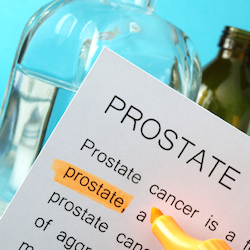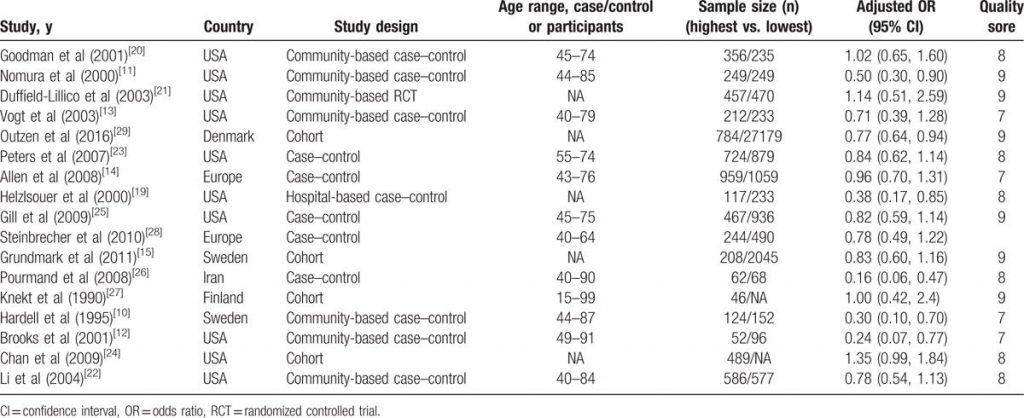It’s been twenty-one years since the first study reported a possible link between elevated serum selenium and prostate cancer risk reduction. In the years since, research has continued to explore this mineral’s role in cancer risk reduction. A literature review in the journal Medicine released this week continues the steady stream of research supporting this viewpoint.
Seventeen of 1352 studies (up to Sept. 2016) were identified as suitable from PubMed, Embase, Medline, and the Cochrane Library. The final review included 6136 prostate cancer cases and >34,901 controls or participants.
The researchers found an inverse association between serum selenium levels and prostate cancer risk. The study subgroups, included case-control studies, current and former smokers, high-grade cancer cases, advanced cancer cases, and different populations.
Figure 1 Study Design, Sample Size and Odds Ratio
The researchers said the likely mechanism for their conclusion has multiple origins:
- Selenium is an “important component of 3 major proteins: selenoprotein-P, glutathione peroxidase (GPx), and albumin. Within GPx, selenium is part of the most important antioxidant enzyme system that prevents cellular injury.”1
- In addition, “selenium inhibits the expression of some oncogenes and promotes apoptosis.”2
- Also, selenium is a “part of the most important antioxidant enzyme system involved in preventing peroxidation of cells.3 Like vitamin E, selenium may be a superior scavenger of reactive nitrogen oxide species, and has the capacity to decrease inflammation.”
- “Selenium also inhibits cell proliferation and decreases cell cycle progression through the reduction of cyclin in prostate cancer cell lines.”4
They also noted that this meta-analysis was inconsistent with a popularized study called the SELECT trial, which was halted early because it did not show a relationship between selenium and prostate cancer risk reduction.5
A subsequent study by John Richie PhD, published on Today’s Practitioner showed that the SELECT trial most likely used the wrong form of selenium.6 Richie’s study at Penn State University showed that selenomethionine (used in SELECT trial) had no effect on prostate cancer biomarkers. But instead, a National Cancer Institute standardized, food form of high selenium yeast (SelenoExcell) did significantly reduce oxidative stress biomarkers for prostate cancer.
Richie and his colleagues concluded that his study should put to rest the confusion caused by the SELECT trial’s use of synthetic SeMet, and that selenium form matters when it comes to form and function.
For this most recent study, the researchers conclude there is an inverse relationship between serum selenium levels and subsequent prostate cancer risk. They call for further investigations using well-designed cohort studies based on non-Western populations, as this literature review was primarily 0f subject from western Europe and the United States.
Resources
1 Rejali L, Jaafar MH, Ismail NH. Serum selenium level and other risk factors for breast cancer among patients in a Malaysian hospital. Environ Health Prev Med 2007;12:105–10.
2 Carlos WG, Curtis Ramsey M, Fraiz J. Selenium in early sepsis: a marker for change? Advances in Sepsis 2007;6:99–102.
3 Van’T Veer P, Van der Wielen RP, Kok FJ. Selenium in diet, blood, and toenails in relation to breast cancer: a case-control study. Am J Epidemiol 1990;131:987–94.
4 Brigelius-Flohe R, Kelly FJ, Salonen JT, et al. The European perspective on vitamin E: current knowledge and future research. Am J Clin Nutr 2002;76:703–16
5. Lippman SM, Klein EA, Goodman PJ, et al. Effect of selenium and vitamin E on risk of prostate cancer and other cancers: the Selenium and Vitamin E Cancer Prevention Trial (SELECT). JAMA 2009;7:30139–51.
6. Richie JP, et al. Comparative effects of two different forms of selenium on oxidative stress biomarkers in healthy men: a randomized clinical trial. Cancer Prev Res (Phila). 2014 Aug; 7(8):796-804.






